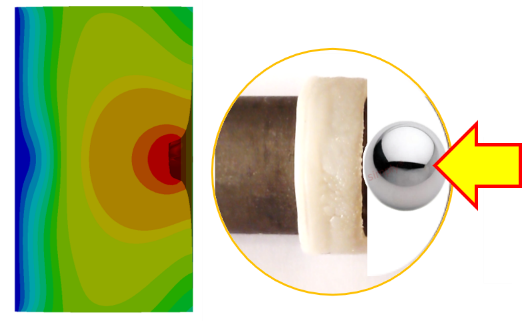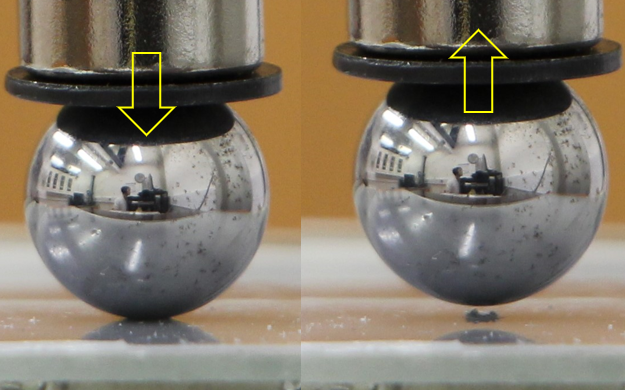Eugene M. Terentjev, Professor of Polymer Physics from the University of Cambridge, describes Smart Plastics, including a radically new polymer system, liquid crystal elastomers and the associated applications
While we are used to automation, machine learning and AI in the technology sector – known as the Fourth Industrial Revolution – polymer researchers at Cambridge have now developed a new class of materials with physical intelligence of their own. These are plastics that feel and respond to their environment, making decisions, analysing and responding to problems without human intervention. Liquid crystalline elastomers are truly the material of the future.
The focus of the Horizon 2020 project APRA (Advanced Grant “Active Polymers for Renewable Functional Actuators”) is achieving autonomy through intrinsic material function rather than relying on embedded electric or mechanical solutions. We have developed these multifunctional polymer materials, and ensured that they remain sustainable by keeping them recyclable and reprocessable despite relying on their crosslinked nature – all made possible by the novel chemistry of dynamic bond exchange.
What are Liquid Crystalline Elastomers?
Liquid crystal elastomers (LCEs) are a radically new polymer system, akin to rubber, but with unexpected properties that arise from its intricate molecular structure. The polymer had rigid rod-like units separated by flexible chains. This structure allows for local liquid-crystalline order with the anisotropy axis, where the rods align. These rods can then rotate separately and independently of the overall rubber-elastic matrix.
The invention and the early studies of LCEs made almost 30 years ago have laid out the fundamentals of understanding these materials. Our research group was at the foundation of these studies. The new generation of robust main-chain LCEs developed under the APRA programme is based on dynamic networks (sometimes called ‘vitrimers’) that allow the post-crosslinking re-moulding of the covalently bonded thermosets, and re-programming their local orientational order. This also makes the material one of the first totally recyclable thermoset plastics.
One unique LCE property is called ‘soft elasticity’, which combines the dissipation properties of a liquid with the mechanical strength of a thermoset to produce levels of vibration damping far above market-leading technologies based on polyurethane or silicone. This plays with the alignment of the rod-like molecular segments as fluctuation in their alignment converts energy to heat, much like friction. The sound or physical vibration will deliver the energy, but none will pass through the material.
Adhesion energy is very closely related to mechanical damping, so LCE can also exhibit a strong pressure-sensitive adhesion (PSA). It will feel sticky to touch and bond to most surfaces. However, simply heating the LCE will turn it into a smooth isotropic elastomer with little or no damping, low surface energy, thus giving a reversible adhesive property to LCE.

The other fascinating effect, which promises ground-breaking applications and devices, is that LCEs reversibly contract and expand on heating and cooling. If the material is programmed to a given shape when aligned, then this will become its natural shape. However, heating the material will cause up to 100-200% contraction, which is fully reversible (the LCE extending back into its natural shape when cooled). This mechanical actuation allows us to design actuators, artificial muscles, or an LCE engine working on a difference in temperature between two containers.
Despite their long history in academic research, LCEs are only beginning to penetrate industrial applications and design, and our team have been at the very beginning of this development. We work together with the start-up Cambridge Smart Plastics, developing marketable LCE applications in vibration isolation, reversible adhesion, microfluidics, and even working on the LCE engine converting waste heat into useful work.

Applications
Vibration and acoustic damping – the simplest use for LCE would be to leverage its internal damping to create sound isolation pads, or dampen vibration from the road to improve the accuracy of LIDARs and/or passenger comfort in ground vehicles. We showed that on impact, over 97% of impact energy is dissipated into heat in the LCE pad, protecting the ‘target’ behind it.
PSA pads – utilising thin layers of LCE will enable fully reversible adhesive tapes that will eliminate the “single-use” nature of today’s adhesives. Most technology, especially many automotive systems, are totally held together by adhesive tapes that must be disposed of and replaced during repairs. LCE adhesive tapes would simply release on heating, or on illumination by light, and then be free to be reused in the same product or elsewhere (https://vimeo.com/642686422).

![]()
“Smart” structures – leveraging the artificial muscle, simple demonstrators have already been produced for heliotracking solar panels. Using the light to trigger the actuation, a platform can be built that will always lean towards the light increasing the contact angle and power generation of the panel (https://vimeo.com/644296504).
Heat to energy conversion – storing waste heat in the LCE will allow energy to be held in the material. This can be through a simple motor design or by lifting weights or pumping water using the LCE’s actuation (https://vimeo.com/642684181).
Bringing the state-of-the-art in polymer science to industry
Cambridge Smart Plastics is a start-up that aims to revolutionise commodity plastics, accelerate innovation and technology translation, and foster our next generation of innovators. Embedded in the University of Cambridge, they are building industrial collaborations and scaling up the demonstrators and technologies developed here to introduce these materials into the market. These LCE materials really have a chance to make a difference with the reversible PSA characteristics making sustainable reusable adhesives tapes viable, or recyclable elastomers for damping applications like isolating LIDARs for increased accuracy and safety of vehicles.
If you would like to learn more or join Cambridge Smart Plastics on this journey, then reach out today. The team is always excited to hear ideas and co-develop applications for this exciting new material.

Active Polymers for Renewable Functional Actuators has received funding from the European Union’s HORIZON 2020 Research programme under the Grant Agreement no. 786659
*This is a commercial profile.
© 2019. This work is licensed under CC-BY-NC-ND.










